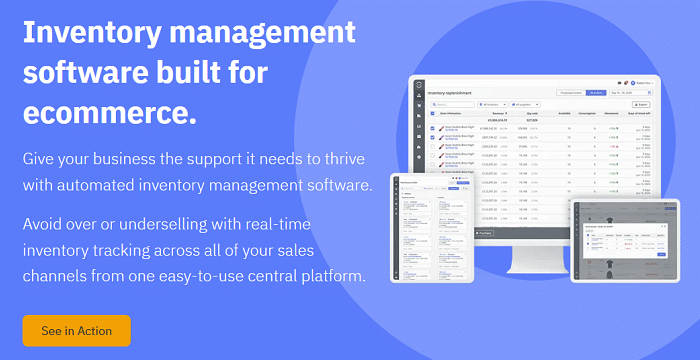Inventory Audit Guide: Types, Benefits and Challenges
Learning how to achieve and maintain inventory accuracy is a vital lesson in Business 101. Perhaps not the most exciting of lessons. But an essential one nonetheless.
That said, we promise it will get more exciting as your overhead costs drop and your profits begin to soar. So, trust us. This 10-minute read is well worth your time.
The long and short of it: Regular inventory audits are your secret weapon for commercial success. Why? Because they give you an eagle-eye view of inventory levels, allowing you to:
- Keep your stockroom running like a well-oiled machine
- Make smarter purchasing decisions
- Reduce unnecessary costs
- Optimize receiving and shipping operations
- Boost sales
In this handy guide for e-commerce owners, we’ll demystify inventory audit procedures and overhead analysis procedures to help you unlock the true potential of your business. We’ll cover:
- What is an inventory audit?
- Why is inventory auditing important?
- The 6 primary types of inventory audit for ecommerce businesses
- Inventory auditing standards
- The 3 most common inventory audit challenges
- How to improve audit accuracy and efficiency with inventory management software
Ready to power up your procedures and develop a kickass inventory audit checklist to guarantee ecommerce triumph? Well, alrighty then! Here’s everything you need to know.
What is an inventory audit?
An inventory audit checks that the physical count of raw materials, direct materials, and products in your storerooms matches what’s on your financial records. In many instances, in-house staff can conduct inventory audits. However, it’s not unusual for businesses to bring in an external auditor to ensure that best practices are followed and that generally accepted auditing procedures are met.
Why is inventory auditing important?
Well, we say important. We’ll level with you. We actually mean essential.
For businesses operating on a D2C model – and particularly those with stock spread across multiple locations and selling platforms – the process couldn’t be more crucial. Performing an inventory audit facilitates:
- Accurate stock management
- Effective financial reporting
- Informed decision-making
- Better overall operational efficiency.
In other words, it makes your life way easier while simultaneously ensuring better business practices and end-of-year balance sheets that will have your bank manager rolling out the red carpet. What’s not to love about that?
Let’s explore some specific business benefits in more detail.
Improved inventory accuracy
Proper inventory control techniques provide a clear snapshot of stock levels, helping you reconcile physical inventory accounts against financial records. This, in turn, helps minimize lost sales and maximize revenue by:
- Preventing overstocking
- Avoiding stockouts
- Mitigating shrinkage
- Optimizing safety stock thresholds
Enhanced financial reporting
Accurate inventory calculations are essential for financial reporting and tax compliance. They help you to:
- Comply with relevant industry regulations and resources like the IRS audit guide
- Ensure your financial records match the value of your physical inventory count
- Improve the quality of your balance sheets, income statements, and tax filings
- Present transparent financial data to stakeholders
Better Decision Making

Because audit procedures provide data on product performance, demand trends, and stock movement, you can:
- Improve demand forecasting accuracy
- Identify top-selling high-value items
- Identify obsolete, missing, and slow-moving inventory
- Optimize stock levels to minimize overhead costs
- Adapt quickly to changing market dynamics
Boosted operational efficiency
Maintaining accurate inventory and accounting records enhances overall operational efficiency, allowing you to:
- Optimize order fulfillment
- Reduce order processing time
- Avoid unnecessary delays
- Identify process inefficiencies like bottlenecks in the supply chain
Higher Customer Satisfaction Scores
When you audit inventory regularly, you can stop overselling and eliminate the potential for customer disappointment by providing consumers with:
- Real-time stock availability
- Prompt and hassle-free order fulfillment
- A smoother returns and exchange processes
- Personalized recommendations and targeted promotions
The 6 primary types of inventory audit for ecommerce businesses
When it comes to mastering the art of inventory auditing, ecommerce businesses have an arsenal of techniques at their disposal. So, it’s time to pick your weapon of choice!
But, which of these common inventory audit procedures represents the nunchucks of the inventory world, and which is the banana peel that leaves your customer carts sliding toward abandonment?
Alas, there’s no black-and-white answer, we’re afraid. Ultimately, the approach that best suits your business and inventory needs will depend on your company’s size, complexity, and desired level of control.
We’ll be delving into each of the inventory audit procedures below in more detail in separate articles (don’t worry, we’ll do our best to dazzle you with our wit and pizazz to make them an interesting read!). But for now, let’s tackle an overview of your main options.
1. The physical inventory count
Physical inventory counts are old-school and time-consuming, but they represent a hands-on way to keep stock discrepancies at bay.
Precisely what happens during a physical inventory count? As the name suggests, it’s a complete physical count of every item in your stockroom, which is then verified and compared to your inventory balance sheet. Here’s how to plan and coordinate a full physical inventory count:
- Run a cutoff analysis to select a time when operations are least active and ensure no inventory leaves or is received during the audit.
- Divide each stockroom/warehouse into manageable sections and assign employees to conduct counts and record qualities.
- Cross-reference with your general ledger and review purchase records, noting any missing inventory and discrepancies.
- Based on your findings investigate item discrepancies and adjust your records to ensure the physical count matches your database.
The pros and cons of physical counts
- You obtain precise data on inventory levels which helps prevent stockouts and overstocking.
- Physical counts expose discrepancies between inventory records and actual stock, allowing you to identify, investigate, and rectify issues.
- For big businesses, a full physical inventory count may lead to temporary sales floor closures that impact customers.
- Human errors caused by fatigue, distractions, or oversight can make inventory count reconciliation an impossible task.
2. Cycle counting

Cycle counting involves frequent, targeted counts of different stock items on a rotating basis. The primary goal is to maintain accuracy while avoiding disruptions to daily operations.
Instead of a comprehensive physical count, a cycle count focuses on counting specific subsets of inventory. Here’s how to plan and coordinate a cycle count:
- Segment your inventory into categories or groups based on criteria like value, demand, or velocity.
- Establish a cycle count schedule, specifying which inventory subsets are counted and when.
- Count your stock, then conduct a reconciling items investigation to identify and scrutinize discrepancies before adjusting your inventory records.
The pros and cons of cycle counts
- Cycle counting allows for the targeted monitoring of specific stock segments, like high-value inventory items and fast-selling products.
- Disruption to daily operations is minimized, reducing the impact on order fulfillment and customer satisfaction.
- Focusing on subsets makes it harder to maintain accuracy, so there may still be undiscovered discrepancies in other inventory categories.
- Cycle counts are typically labor and technology-intensive, and require proper quality control measures to minimize errors.
3. ABC analysis
No, it’s not about the alphabet. But it is about prioritizing your inventory. ABC analysis categorizes your products based on their value and importance:
- A items – Stars like high demand and high value items that deserve extra attention.
- C items – Low demand or low value items that take a backseat.
- B items – Basically everything in between!
The steps to work through are the same as for physical or cycle counts, encompassing various manual and technology-driven procedures for inventory calculation, evaluation, and adjustment against your financial records.
The pros and cons of ABC analysis
- By designing procedures for inventory around sales and profit, you can optimize resources and make better purchasing and pricing decisions to maximize ROI.
- By prioritizing high-value items, you can proactively manage stockouts, discrepancies, and product availability risks.
- ABC counts often oversimplify the importance of items that may have strategic significance beyond their sale value.
- By only focusing on value, you neglect other important factors like seasonality, lead times, and supply chain dependencies.
4. Sample-based inventory audit
When you take a sample-based approach, life really is like a box of chocolates!
With this approach, you select a representative sample of your inventory and conduct a detailed examination. Essentially, it’s like taking a bite from each chocolate to assess the whole box. Here’s how to do it:
- Determine the appropriate sampling method (e.g. random, systematic, or stratified) based on specific criteria like product categories or locations.
- Calculate the sample size required for a statistically significant representation, then count and examine the selected items.
- Estimate overall inventory accuracy using statistical formulas or software tools that record data electronically and calculate actual inventory levels.
The pros and cons of a sample-based inventory count
- You can achieve accurate results while minimizing the time and effort required for a comprehensive physical count.
- Sample-based audits are economical on resources as there are fewer indirect costs than alternative inventory processes like physical counts.
- Using a subset to count inventory means some items of significant operational importance may be overlooked.
- Effective sampling requires statistical knowledge, expertise, and the use of complex formulas, software, and data manipulation tools.
5. Freight cost analysis

Shipping costs can be a sneaky culprit eating into your profits. But calculating the transportation expenses associated with moving inventory can be complex.
Determining shipping costs using freight cost analysis allows you to calculate overall expenses based on the total amount of inventory shipped. The goal is to identify cost-saving opportunities and negotiate better terms. To be successful, you’ll need to:
- Collect data on all freight-related expenses, including transportation fees, fuel surcharges, handling charges, transfer documentation, etc.
- Categorize each expense into specific indirect cost components, such as carrier fees, packaging costs, customs charges, insurance expenses, etc.
- Review carrier contracts and pricing agreements to ensure they are competitive.
- Identify potential areas for cost reduction, like consolidating shipments, negotiating volume discounts, or exploring alternative shipping methods.
The pros and cons of freight cost analysis
- By identifying areas of excessive spending, you can implement strategies to reduce expenses and improve overall profitability.
- Gaining deeper insight into how shipping expenses impact your bottom line enables more accurate forecasting for the next financial reporting period.
- External factors such as fuel prices, regulatory changes, or market fluctuations may impact the overall accuracy of freight-based calculations.
- Many factors that influence receiving and shipping operations (like carrier rates and customs fees) are beyond your control, limiting the potential for cost reduction via freight cost analysis alone.
6. Finished goods cost analysis
This audit methodology unravels the relationship between business expenses and profitability by evaluating the total cost of producing and delivering your products.
We know what you’re thinking. Exactly how do you audit inventory based on overall cost? Unfortunately, the answer isn’t particularly straightforward as there’s a lot – and we mean, A LOT – of overhead analysis involved in this methodology.
Honestly, it’s probably easier to wait for the full article on this one before subjecting your calculator to a full cardio workout. But, to get started, you’ll need to run an indirect vs. direct labor analysis and add up all of your manufacturing expenses, including:
- Raw and direct materials costs
- Manufacturing, packaging, and storage expenses
- Transport and distribution overheads
The pros and cons of a finished goods cost analysis
- Understanding the true costs of finished goods ensures accurate pricing decisions based on real-world production and delivery expenses.
- Managing inventory based on the profitability of individual products/categories helps you focus on high-margin offerings.
- Obtaining accurate and reliable inventory cost data can be challenging, especially when dealing with complex production processes and components.
- Conducting a comprehensive finished goods analysis can be time-consuming and resource-intensive, particularly for businesses with diverse product lines or complex manufacturing processes.
Inventory Auditing Standards
Of course, an accurate inventory audit isn’t just about counting stock. There are financial implications too – like keeping your business in the good graces of the number-crunching overlords to avoid potential tax troubles. Plus, each company will also have its own set of warehouse protocols to standardize internal operations and the management of inventory audits.
Financial Standards

The last thing you want to do is put a target on your back by leaving the authorities scratching their heads in confusion when they look at your audit records or accounts. Plus, investors and stakeholders love it when you show them clean, reliable numbers.
So, is there a generally accepted auditing procedure that businesses worldwide should follow? Good question…
In the United States, your company’s financial statement audit is governed by Internal Revenue Service (IRS) and the Securities and Exchange Commission (SEC) guidelines. In the United Kingdom and Europe, inventory ownership and financial oversight are governed by the International Financial Reporting Standards (IFRS), which are issued by the International Accounting Standards Board (IASB).
What do these agencies and their standards mean to you and your business? Here’s a quick low down.
The IRS
The IRS allows businesses to choose among several appropriate procedures for cost flow assumptions, including FIFO (First-In, First-Out), LIFO (Last-In, First-Out), and weighted average. These assumptions determine how inventory costs are allocated and impact financial statements and tax calculations. Businesses must select an appropriate cost flow assumption and consistently apply it.
The SEC
The SEC oversees financial reporting standards for all publicly traded US companies. SEC auditing rules require companies to follow either Generally Accepted Accounting Principles (GAAP) or International Financial Reporting Standards (IFRS) standards, both of which provide guidelines for inventory valuation, measurement, disclosure, and overall presentation of financial statements.
The IFRS and AISB
These two regulatory bodies are inextricably linked. The yin and yang of financial reporting on an international scale, if you will. The IASB is an independent organization that sets the International Financial Reporting Standards. Compliance ensures that businesses follow internationally recognized accounting principles for inventory ownership, facilitating transparent financial reporting across international borders.
Warehouse Standards
Internal processes and technologies will vary depending on the specific operational needs of the business. However, some key considerations for designing a set of standard operating procedures include:
- Inventory tracking/control – Systems must be capable of accurately tracking stock levels and movements to ensure full visibility, minimal errors, and prevent loss or theft.
- Storage and organization – Proper racking, labeling, and categorization processes are vital in optimizing space utilization and minimizing picking errors.
- Stock reconciliation – Regular stock reconciliations are required to identify discrepancies and manage stockouts, overstocking, and shrinkage.
- Quality control – The condition of all inventory products must meet the specified quality standards.
- Accurate documentation – Maintaining accurate and up-to-date inventory records ensures traceability and supports accurate financial reporting.
- Staff training – Employees should be up-to-date with training on inventory handling techniques, accurate data entry, and adherence to stock control procedures.
The Perils of Neglecting Inventory Audits
We know there’s a lot to consider and that bending your head around the inventory management process can feel a bit overwhelming. But, consider it you must, because skipping any of the inventory audits required or failing to conduct regular audits can lead to mishaps on multiple fronts:
- Compliance – The penalties, legal issues, and reputational damage resulting from a failure to meet industry requirements can be hard to bounce back from.
- Inaccurate financial reporting – Compliance issues aside, incorrect/insufficient audits lead to inaccurate financial statements and distorted profit margins.
- Inefficient inventory management – When you don’t have a handle on your stock levels, you’ll make poor inventory replenishment decisions, leading to stockouts, excess inventory, and cash flow problems.
- Increased operational risk – Businesses without a reliable inventory management process are vulnerable to inventory shrinkage, theft, and mismanagement – and the associated negative effects of those on profitability, customer satisfaction, and overall business reputation.
The 3 most common inventory audit challenges

The path to inventory management finesse and stellar financial reporting is not without obstacles. But, as luck would have it, the Linnworks team is on hand with some top tips to help you clear the hurdles.
1. The Time Factor
There’s no denying that inventory audits demand time and attention. Counting and verifying every item can feel like a never-ending task, pulling you away from other essential business activities. So savvy bosses quickly learn to:
- Plan and schedule audits in advance to minimize disruption.
- Embrace technology by utilizing barcode scanning to speed up the process.
- Research reliable software options to alleviate the burden and save valuable time.
2. Scalability Issues
As your business expands, so does your inventory, and audits become notoriously complex when you’re juggling multiple stockrooms, warehouses, and sales channels. Taking these steps can help:
- Implement a centralized inventory management system to streamline data across all locations.
- Leverage automation tools for real-time tracking and synchronization.
- Establish standardized processes and documentation to ensure consistency and accuracy.
Operational Obstacles
The disruption of an inventory audit can slow daily operations, affecting productivity and customer satisfaction. And the infamous cutoff analysis adds a layer of additional complexity. We recommend you:
- Plan audits during periods of lower activity.
- Utilize software with built-in cutoff analysis features to automate the process.
- Train staff on efficient audit procedures to minimize disruptions and maintain operational efficiency.
How to improve accuracy and efficiency with Linnworks inventory management software
It’s time to wave goodbye to inventory mayhem and say hello to organized bliss. When it comes to improving accuracy and efficiency, Linnworks inventory management software is a shining example of all of the best ways to optimize your processes. Let’s explore a few core features:
- Centralized inventory control – Storing data from multiple sales channels, warehouses, and locations on a centralized platform alleviates scaling struggles by synchronizing inventory data in real time, ensuring consistency and accuracy across your entire business operation.
- Barcode scanning and automation – Scanning items reduces manual errors, saves time, and improves accuracy during physical inventory counts. Plus, automation features enable swift data entry and updating, minimizing the time-consuming trials of manual data input.
- Real-time stock monitoring – With accurate and up-to-date real-time data, you can make informed reordering and replenishing decisions to avoid dreaded stockout situations that cause operational disruptions and customer dissatisfaction.
- Reporting and analytics – With detailed insights into sales trends, demand patterns, and stock movement, you can make data-driven decisions about product assortment, develop better pricing strategies, and improve financial reporting accuracy.

Whether you’re a small local business (for now, we can work on your growth together!) looking for a better warehouse management system, a national ecommerce merchant wanting to streamline inventory across various channels and locations, or a large brand on a quest to scale internationally, the team at Linnworks has the solutions and expertise you need.
But you needn’t simply take our word for it. Not when there’s a whole boatload of happy, successful – and, most notably, stress-free – clients who are happy to do the talking for us:
“Now the jobs that we’d employ someone to do for a whole day are automated with Linnworks, saving us time and overheads.” – Arthur Martin, Managing Director at Wholefoods Online
“With Linnworks, we have one location to manage all our inventory and don’t have to assign stock to each separate channel. It means we can make more of our range available wherever customers are finding our products online.” – Luca Salamone, Marketing Manager at Retro Styler
“Our eBay business partner asked if we were prepared for the new business and I confidently explained we have Linnworks so I’m not worried at all.” – John Hohn, owner of JAF Comics
Ready to join the growing list of businesses that have already revolutionized their inventory accuracy and reporting with our innovative and intuitive software solutions?
Take 3 minutes out of your day to take our interactive product tour and learn more about effortless inventory and order management with Linnworks. We promise you won’t regret it!
Inventory audit FAQs
What is an inventory audit?
An inventory audit is a systematic examination or verification of a company’s stock of goods. It assesses the accuracy of the recorded inventory and helps prevent fraud, shrinkage, or other irregularities.
How do you audit inventory?
An inventory audit involves several steps, including planning, testing inventory count procedures, inspecting physical inventory, validating inventory ownership, valuation, and finally preparing a detailed report. It’s typically carried out by internal auditors or an external auditing firm.
What to look for when auditing inventory?
When auditing inventory, auditors look for discrepancies between recorded and actual stock, evaluate the condition of inventory for possible obsolescence, check the appropriateness of valuation methods, verify ownership of the inventory, and ensure compliance with relevant accounting standards.